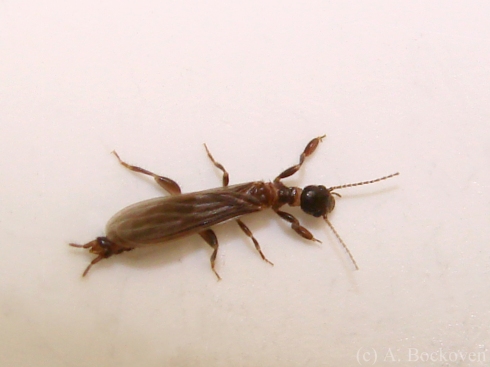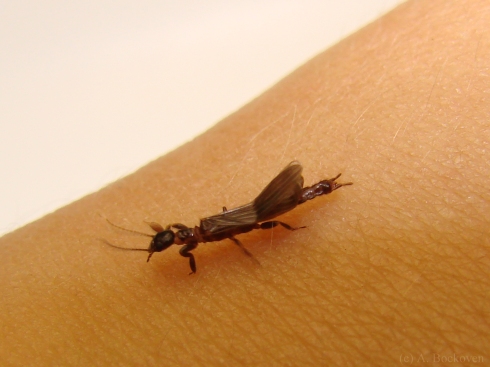So I have a story to tell about the picture above. See, that guy up there is a webspinner, a member of the order Embioptera, a fascinating but often overlooked little group of insects. I spent most of last spring looking for a webspinner because these guys were worth super-extra bonus points for our class collection. I peeled bark off trees. I journeyed to a location where one of my undergraduate students had stumbled across one. Twice. But no luck.
Then, a few nights ago, I was sitting at home, reading a book and minding my own business, and an embiopteran fluttered up and landed on my nose. Life is strange.
Luckily, my entomologist instincts are well-honed enough at this point that I reacted to the sudden presence of an unknown insect on my face by attempting to determine what it was. I then had a few frantic excited moments of “catch it! catch it!” before I secured my prize: an adult male webspinner.
Webspinners, as I have mentioned, are members of the order Embioptera, meaning “lively winged.” No one seems to agree quite why this is, though a few sources suggest this is in reference to the ‘lively fluttering of the males’ wings.’ Webspinners take their common name from their living habits. They spin silken tubes, called galleries, in which they reside most of their lives (males may leave their tubes to seek a mate). Often they form their galleries in large communities, under bark or rocks. They have several very interesting adaptations for this lifestyle. Most notably, they have special silk making gland in the enlarged segments at the base of their swollen fore-tarsi (in essence, their front feet–see the first picture). Although all insects make silk at some point in their lives, they are the only insects to have glands in their feet.
Webspinners are also adapted to move about in their silken tubes. They have long slender bodies, and can move rapidly backwards and forwards. Their large hind femurs (essentially their hind thighs) assist in backwards movement, and the two sensitive filaments at the end of their abdomen (cerci) allow them to feel their way along the tunnel backwards. In addition, females are wingless, somewhat resembling earwigs. Adult males, like many insects, need wings to fly and search out females. Thus, male webspinners have a special adaptation to keep their wings from hindering them in the tunnels: their wings are soft and floppy, folding forwards for backwards movement. In order to provide the stiffness necessary for flight some wing veins are adapted into blood sinuses, and can be pumped full of hemolymph to stiffen them.





Never have found one of these insects yet – these and Zoraptera remain my only missing orders.
I also had difficulties to find them, knew them from Mediterranean soils but never sampled one! Then, I went to Elba Island (Central Italy, UE), @ “Fetovaia” beach, and… twice in two different years, always in June, it were them who found me! Both times, I simply was lying on the ground between sand and pinewood, and found one on my mat, climbing it to be sampled for free! ;)))
Very interesting.It’s the first time I’ve seen photographs of these. I don’t think I would react so calmly if one landed on my nose!
They are completely harmless!!!
Can you tell us what they feed on? just curious.
They feed on dead vegetation, mosses, and fungi that they find within their silk galleries.